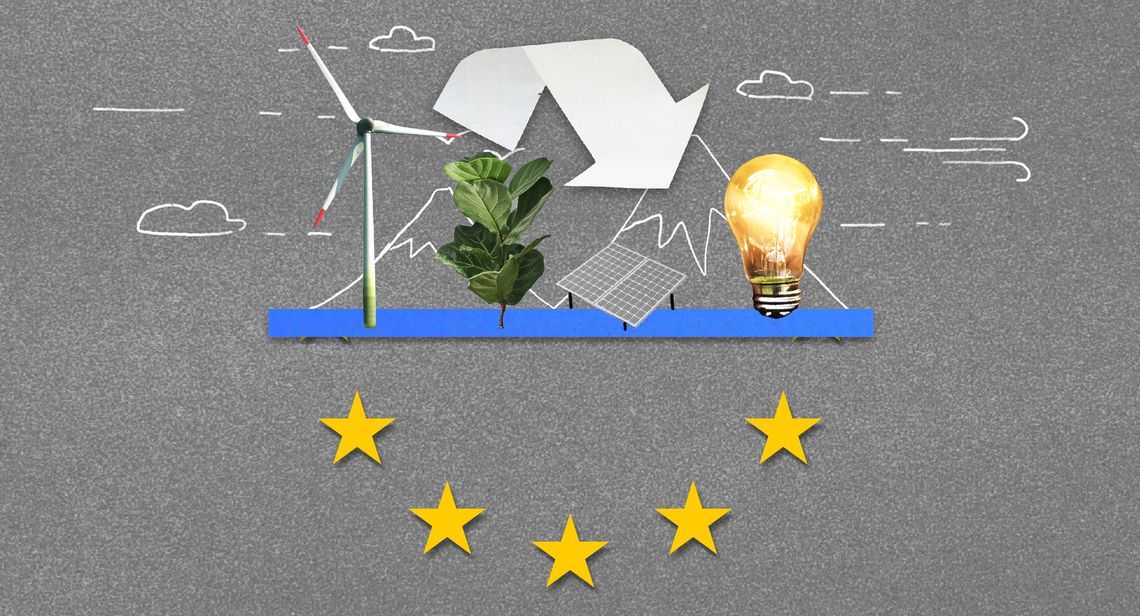

Illustration by Armine Shahbazyan.
One of the most important dimensions of Armenian-EU cooperation is the energy sector, which has its basis in the recently-adopted Comprehensive and Enhanced Partnership Agreement (CEPA). CEPA entered into force on March 1, 2021, as the main document regulating EU-Armenia relations. Energy cooperation is covered in Title V, Chapter 2, which highlights the following areas:
- energy strategy and policy, including for the promotion of energy security and diversity energy supplies and power generation
- enhancement of energy security, including the diversification of energy sources
- development of competitive energy markets
- promotion of the use of renewable energy resources, energy efficiency and savings
- promotion of regional cooperation
- promotion of common regulatory frameworks to facilitate trade in oil products
- the civil nuclear sector, taking into account the peculiarities of Armenia and paying special attention to a high level of nuclear safety
- exchange of technologies and best practices in the field of safety
- tariff policy
- scientific and technical cooperation
Diversification of the energy supply is one of the main pillars of energy security. The EU has expressed a willingness to support Armenia in designing an energy strategy and policy.
Currently, without the output of the Metsamor Nuclear Power Plant (NPP), Armenia would not be able to guarantee its basic energy demand. It accounts for about a quarter of electricity generation, and allows Armenia to be a net exporter of electricity to its regional market (Georgia and Iran). The plant had been shut down as a precautionary measure after the 1988 Spitak Earthquake, but then was restarted in 1995 after an energy blockade by Azerbaijan and Turkey led to rolling blackouts in the country.
One of the building blocks of the European Union was the European Atomic Energy Community. While the EU has expressed concerns about the Metsamor NPP, a peer review report triggered after the 2011 Fukushima accident found Armenia’s only nuclear power plant to be in compliance with the International Energy Agency’s safety standards.
In order to connect Armenia to the EU power grid, European investments seek to strengthen transmission interties between Armenia and Georgia. While the possibility of constructing a new nuclear plant has been discussed to replace Metsamor, the EU has taken a position against the construction of new nuclear plants in Europe. In February 2021, the European Parliament adopted a resolution on the safety of the nuclear power plant in Ostrovets, Belarus, calling for delaying construction and following European standards. The European Parliament “Deeply regrets the hasty commercial start of the plant in March 2021 and stresses that all ENSREG safety recommendations must be implemented before the nuclear power plant can start its commercial operation; encourages the Commission to work closely with the Belarusian authorities in order to suspend the starting process until all EU stress test recommendations are fully implemented and all necessary safety improvements are in place, and after Belarusian society and neighboring countries have been duly informed of the measures taken.”
Fully understanding the critical role that the Metsamor NPP plays in Armenia’s current energy infrastructure, EU had hoped to reduce that dependence through diversifying Armenia’s sources of energy, including renewable sources. At the onset of the 2000s, during a meeting of the European Commission-Armenia joint working group, the EU offered a $100 million grant proposal in exchange for closing the Metsamor NPP. The offer included construction or renovation of existing hydroelectric power plants (€34 million), and €16 million for the restoration and construction of gas transportation infrastructure in Armenia facilitating gas imports from Iran. The Armenian government eventually rejected the deal and the grant proposal was halted.
The EU is a major advocate of green technology in Armenia and European Neighborhood countries in general. It was one of the priorities of the Eastern Partnership Policy Beyond 2020 document, adopted in March 2020, according to which massive investments are required to transform the neighborhood into a wealthy zone with resource-efficient, clean, circular and competitive economies.
In the framework of the Eastern Partnership, which includes Armenia, Georgia, Azerbaijan, Ukraine, Belarus and Moldova, the EU is implementing the EU4Energy project to support a more reliable energy supply, and promote energy efficiency and the use of renewable energy. Its main activities include supporting the Armenian government in elaborating better energy policies and regulation. As part of EU4Energy, the Energy Charter is an international agreement that establishes a multilateral framework for cross-border cooperation in the energy industry. Priority areas include establishing energy efficiency measures for buildings and guidelines for minimum energy performance requirements. This year, Armenia took up the rotating chairmanship of the Energy Charter Conference.
Armenia is also an observer of the European Energy Community, which was established in 2005 and includes all the members of the European Union, along with countries from South-East Europe and the Black Sea region. Armenia has held observer status since 2011.
The main objective of the Energy Community is to extend the EU internal energy market rules and principles to countries in South-East Europe, the Black Sea region and beyond, on the basis of a legally-binding framework. However, Armenia’s engagement in the energy community could be limited, as Armenia is a member of the Eurasian Economic Union (EAEU) and aspiring to be part of the common Eurasian energy market.
Another important project implemented within the framework of EU4Energy is the Municipal Project Support Facility (MPSF), which was set up in 2015 with a very specific aim: to help municipalities access the financing necessary to deliver energy efficiency investments and financial savings. It has a budget of €12 million running to 2022 to help local authorities identify suitable funding projects and submit applications. It is helping to introduce energy-efficiency measures in 190 public buildings, mainly kindergartens, and providing assistance to the Yerevan Municipality for energy audits and feasibility studies to improve energy performance.
Another exciting facility is the South Caucasus Sustainable Energy Finance facility, which aims to promote investment in energy efficiency technologies in the three South Caucasus countries—Armenia, Azerbaijan and Georgia—by helping small-scale energy efficiency projects to save money and reduce emissions. The main tool of the implementation is establishing credit lines with local banks and providing technical, financial and legal expertise. The EU is also supporting communities to switch to green energy. This is just a drop in the ocean, but it has crucial importance to changing the social habits and business culture of ordinary Armenians. For the large-scale changes, there is a need for political will to move into greener energy and use the untapped potential of Armenia’s renewable sources.
The Gituzh Initiative: Why Armenia Needs Science
Prioritizing science will pave the way towards economic and strategic development. Formed by industry representatives, the Gituzh initiative is working to increase public awareness and government funding for science development.
Read moreBetween Belt and Road
Armenia and China share a rich history in which mercantilist Armenians played a noteworthy role in the exchange of goods along the Silk Road. Although the Armenian state today is vastly different from a millennium ago, that industrious character remains in the Armenian spirit.
Read moreInterrupted Flavors: Thoughts on Armenian Cuisine
Attitudes toward food and culinary art can reveal much about a people’s past and future. Ella Kanagerian writes that we are trying to work with our cultural influences and approach the concept of national cuisine more consciously.
Read more



